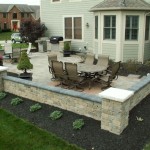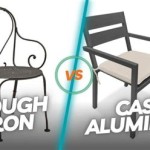Small Brick Patio Ideas: Maximizing Your Outdoor Space
A small brick patio presents a versatile opportunity to enhance the aesthetic appeal and functionality of a limited outdoor area. Effective design and material selection are paramount in creating a space that is both visually pleasing and practical. Careful consideration of the patio's intended use, existing landscape features, and the homeowner's personal style are essential for a successful project.
The inherent appeal of brick lies in its durability, timeless charm, and the wide array of colors and patterns it offers. This allows for customization to complement the existing architecture of the home and the surrounding garden. From classic herringbone patterns to more contemporary running bond layouts, the design possibilities are extensive. This article explores several strategies and considerations for designing and implementing a small brick patio, focusing on maximizing space, enhancing visual appeal, and ensuring long-term durability.
Space Optimization Strategies
One of the primary challenges in designing a small patio is maximizing the available space. Careful planning and strategic design choices can make even the smallest area feel larger and more inviting. Several techniques can contribute to achieving this goal.
Firstly, consider the shape of the patio. A square or rectangular patio might seem like the most obvious choice, but an irregularly shaped patio, perhaps curving around existing garden beds or features, can create a more organic and visually interesting space. An organically shaped patio can also create a sense of flow and movement, making the area feel larger than it is. It is advisable to carefully measure the available space and sketch out several different shape options before settling on a final design.
Secondly, the choice of brick size and layout can significantly impact the perception of space. Smaller bricks tend to make an area appear larger, while larger bricks can make a space feel more enclosed. Similarly, the layout pattern can influence the perceived size. A simple running bond pattern, where bricks are laid in straight lines with offset joints, is a classic choice that can make a narrow space feel longer. A herringbone pattern, on the other hand, can add visual interest and texture but might not be the best choice for a very small space as it can feel busier and more compacting.
Thirdly, incorporating vertical elements can draw the eye upwards and create a sense of height. This can be achieved through the use of strategically placed planters, trellises, or even a small water feature. Vertical plantings can also provide shade and privacy, making the patio feel more secluded and intimate. When incorporating vertical elements, it is important to consider their scale and proportion to the overall size of the patio. Overly large or imposing structures can overwhelm the space and make it feel even smaller.
Finally, the integration of the patio with the surrounding landscape is crucial. A seamless transition between the patio and the garden can blur the boundaries and create a sense of continuity. This can be achieved by using similar materials or colors in both areas, or by incorporating plants that spill over the edges of the patio. Consider creating a small pathway leading from the patio to other areas of the garden, encouraging exploration and making the space feel less isolated.
Enhancing Visual Appeal Through Design and Material Selection
The visual appeal of a small brick patio is heavily influenced by the choice of materials, colors, and design elements. By carefully considering these factors, it is possible to create a patio that is not only functional but also aesthetically pleasing and complements the overall style of the home and garden.
The color of the brick is a key consideration. Red brick is a classic and timeless choice, but there are many other options available, including shades of brown, gray, and even white. The choice of color should be based on the existing color palette of the home and garden, as well as the homeowner's personal preferences. Lighter colored bricks can make a small space feel brighter and more open, while darker colored bricks can create a more dramatic and intimate atmosphere.
The texture of the brick can also contribute to the overall visual appeal. Smooth bricks have a clean and modern look, while textured bricks can add character and warmth. Consider the texture of the surrounding materials, such as the siding of the house or the paving stones of a nearby walkway, and choose a brick texture that complements those elements. Reclaimed or antique bricks can add a unique and rustic charm to a patio, but they may also be more expensive and require more maintenance.
The layout pattern of the bricks is another important design element. The running bond pattern is a simple and versatile choice that works well in most situations. Other popular patterns include herringbone, basketweave, and stacked bond. Each pattern has its own unique visual effect, and the choice of pattern should be based on the size and shape of the patio, as well as the desired aesthetic. More complex patterns can add visual interest and character, but they may also be more difficult to install and require more precise cutting.
Incorporate decorative elements such as borders, edgings, or inlays to add visual interest and define the space. A contrasting border of different colored bricks or paving stones can create a sense of enclosure and frame the patio. An inlay of decorative stones or tiles can add a touch of elegance and personality. When incorporating decorative elements, it is important to maintain a sense of balance and proportion. Overly elaborate or ornate details can overwhelm a small space and detract from its overall appeal.
The lighting of the patio can also significantly enhance its visual appeal, especially in the evening hours. Soft, ambient lighting can create a warm and inviting atmosphere, while strategically placed spotlights can highlight architectural features or plantings. Consider using a combination of different types of lighting, such as string lights, pathway lights, and spotlights, to create a layered and dynamic lighting scheme. Solar-powered lights are a convenient and energy-efficient option for lighting a small patio.
Ensuring Long-Term Durability and Maintenance
A well-designed and properly installed brick patio should provide years of enjoyment with minimal maintenance. However, certain steps must be taken to ensure the long-term durability of the patio and prevent common problems such as cracking, settling, and weed growth.
Proper site preparation is essential for a durable brick patio. The area should be excavated to a depth of at least 6 inches, and the soil should be compacted to provide a stable base. A layer of gravel or crushed stone should be added to provide drainage and prevent frost heave. The gravel layer should be compacted before adding a layer of sand, which will provide a level surface for the bricks.
Choosing the right type of brick is also crucial. Paver bricks are specifically designed for outdoor use and are more durable and resistant to weathering than standard building bricks. Paver bricks are typically made from clay or concrete and are available in a variety of sizes, shapes, and colors. Choose a brick that is rated for the intended use and that is appropriate for the climate in which it will be installed.
Proper installation is critical for preventing problems such as cracking and settling. The bricks should be laid tightly together, with minimal gaps between them. A rubber mallet should be used to tap each brick into place, ensuring that it is level and stable. The gaps between the bricks should be filled with sand or polymeric sand, which will help to lock the bricks together and prevent weed growth. Polymeric sand is a special type of sand that contains polymers that bind together when wet, creating a more durable and weed-resistant joint.
Regular maintenance is essential for keeping the patio looking its best and preventing long-term damage. The patio should be swept regularly to remove debris and prevent staining. Weeds should be removed promptly to prevent them from spreading and damaging the patio surface. The patio should be cleaned periodically with a mild detergent and water to remove dirt and grime. Avoid using harsh chemicals or abrasive cleaners, as these can damage the bricks.
Sealing the patio can help to protect it from stains and weathering. A sealant can also enhance the color of the bricks and make them easier to clean. Choose a sealant that is specifically designed for use on brick and follow the manufacturer's instructions carefully. Reapply the sealant every few years, or as needed, to maintain its effectiveness.
Addressing any problems promptly can prevent them from escalating and causing more significant damage. Cracks should be repaired immediately to prevent water from seeping into the base and causing further damage. Settled areas should be leveled and re-compacted to prevent tripping hazards. By taking these steps, it is possible to ensure that a small brick patio remains a beautiful and functional addition to the home for many years to come.

Making Your Outdoor Living Space More Eoyable Dig This Design Small Brick Patio Garden Backyard Designs

Brick Patio Ideas Landscaping Network

15 Gorgeous Diy Small Backyard Decorating Ideas Landscaping Garden

Simple And Affordable Brick Patio Design Able Plan Mypatiodesign Com

Diy Small Brick Patio Design Able Plan Mypatiodesign Com
:strip_icc()/102130310-2a22a1734f874ffc995dcbe466478177.jpg?strip=all)
16 Brick Patio Ideas That Ll Give You Major Backyard Envy

Small Patio Pavers Ideas Paver House

How To Make Your Yard Private Courtyard Landscaping Privacy Small Backyard

Brick Patio Ideas Landscaping Network

Small Paver Patio Design Layout And Material List Mypatiodesign Com
Related Posts








